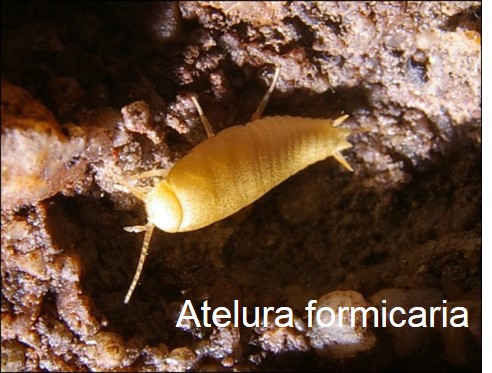

Transferts de gènes et transposons
Alain Lenoir - mis à jour 25-Aoû-2022
Les transferts de gènes entre organismes sont beaucoup plus fréquents que ce que l'on pouvait imaginer ! On les qualifie de transferts horizontaux. Les transposons, fragments de gènes dont le rôle est inconnu, passent ainsi d'une espèce à une autre.
En voici quelques exemples :
Transposons :
Le génome des fourmis comme Tapinoma erraticum et Aphaenogaster subterranea est envahi par des transposons (Lorite et al. 2002; Lorite et al. 2012).
Des transposons peuvent passer horizontalement entre des fourmis Azteca (Palomeque et al 2015). Des transferts de gènes mariners Mboumar and Azteca ont été observés chez des poissons d'argent myrmécophiles Atelura formicaria, provenant de leur hôte Formica cunicularia (Sanllorente, Lenoir et al 2015).
Voir
- Ayala-Ruano, S., D. Santander, E. Tejera, Y. P. Castillo and V. D. Armijos
Jaramillo (2019). A putative antimicrobial peptide from Hymenoptera in the megaplasmid
pSCL4 of Streptomyces clavuligerus ATCC 27064 reveals a singular case of horizontal
gene transfer with potential applications. Ecology and Evolution sous presse.
DOI: 10.1002/ece3.4924
-
Colgan, T. J., A. N. Arce, R. J. Gill, A. Ramos Rodrigues, A. Kanteh, E. J.
Duncan, L. Li, L. Chittka and Y. Wurm (2022). Genomic Signatures of Recent Adaptation
in a Wild Bumblebee. Molecular Biology and Evolution 39(2). doi: 10.1093/molbev/msab366.
- Etienne, V. (2012) Aliments. Leurs gènes modifient les nôtres.
Science et Vie, 92-97.- Fukatsu, T. (2010). A fungal past to insect color. Science
328: 574-575.
- Fukatsu, T. (2010). A fungal past to insect color. Science 328: 574-575.
- Gilbert, C., S. Schaack, J. K. Pace II, P. J. Brindley and C. Feschotte (2010).
A role for host-parasite interactions in the horizontal transfer of transposons
across phyla. 464(7293): 1347-1350.
- Gompel, N. and B. Prud'homme (2016). La bactérie qui donnait la nausée
aux puces. Le Monde 13 juillet 2016. Pdf
- Kapheim, K. M., H. Pan, C. Li, S. L. Salzberg, D. Puiu, T. Magoc, H. M. Robertson,
M. E. Hudson, A. Venkat, B. J. Fischman, et al. (2015). Genomic signatures of
evolutionary transitions from solitary to group living. Science 348(6239): 1139-1143.
10.1126/science.aaa4788
- Le Monde (2019). Les plantes échangent des gènes. Le Monde Science
et Médecine 20 Février 2019. Pdf
- Le Vaux, A. (2012) OGM et santé : la polémique éclate
à nouveau. Courrier International, 46.
- Lorite, P., S. Renault, F. Rouleux-Bonnin, S. Bigot, G. Periquet and T. Palomeque
(2002). Genomic organization and transcription of satellite DNA in the ant Aphaenogaster
subterranea (Hymenoptera, Formicidae). Genome 45: 609-616.
- Lorite, P., X. Maside, O. Sanllorente, M. Torres, G. Periquet and T. Palomeque
(2012). The ant genomes have been invaded by several types of mariner transposable
elements. Naturwissenschaften 99(12): 1007-1020. 10.1007/s00114-012-0982-5
- Lucas, E. R. and L. Keller (2018). New explanation for the longevity of social
insect reproductives: Transposable element activity. Proceedings of the National
Academy of Sciences. 10.1073/pnas.1806014115
- Moran, N. A. and T. Jarvik (2010). Lateral transfer of genes from fungi underlies
carotenoid production in aphids. Science 328: 624-627.
- Palomeque, T., O. Sanllorente, X. Maside, J. Vela, P. Mora, M. I. Torres,
G. Periquet and P. Lorite (2015). Evolutionary history of the Azteca-like mariner
transposons and their host ants. Sci. Nat. 102(44). DOI 10.1007/s00114-015-1294-3
- Phillips, M. L. (2012) Bacterial gene helps coffe beetle get its fix.
Nature News.
- Rocha, E. P. C. (2013) With a Little Help from Prokaryotes. Science 339(6124),
1154-1155.
- Sanllorente, O., J. Vela, P. Mora, T. Palomeque, A. Lenoir and P. Lorite (2015).
Presence of ant transposons in the genome of the silverfish Atelura formicaria
(Zygentoma, Ateluridae). 28 Congrès Union Internationale pour l'Etude
des Insectes Sociaux, Tours 26-28 août. Tours: p.127. Voir le résumé
et le poster
- Schrader, L., J. W. Kim, D. Ence, A. Zimin, A. Klein, K. Wyschetzki, T. Weichselgartner,
C. Kemena, J. Stökl, E. Schultner, et al. (2014). Transposable element
islands facilitate adaptation to novel environments in an invasive species.
Nat Commun 5. 10.1038/ncomms6495
- Schönknecht, G.Chen, W.-H.Ternes, C. M.Barbier, G. G.Shrestha, R. P.Stanke,
M.Bräutigam, A.Baker, B. J.Banfield, J. F.Garavito, R. M. et al (2013)
Gene Transfer from Bacteria and Archaea Facilitated Evolution of an Extremophilic
Eukaryote. Science 339(6124), 1207-1210.